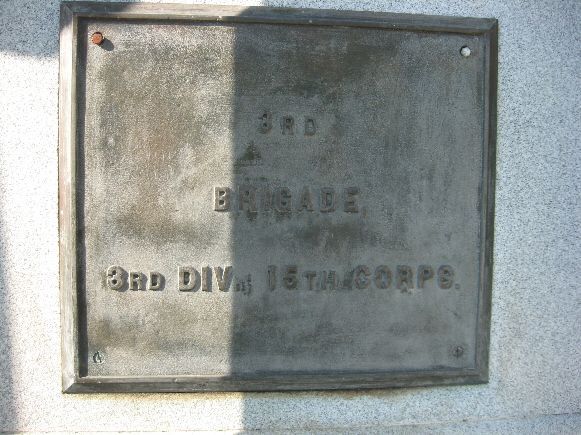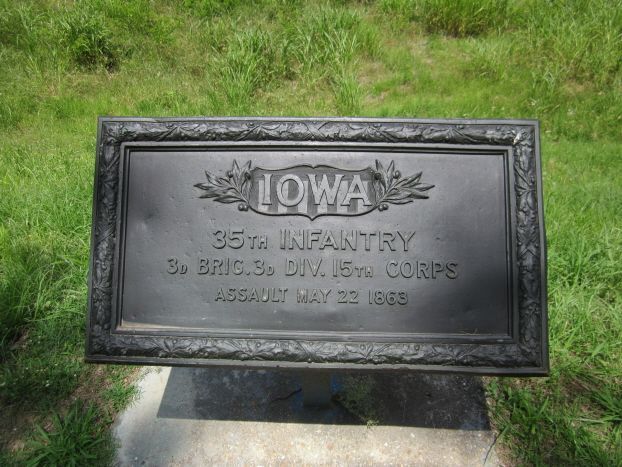
Iowa Civil War Monuments
Mississippi
Vicksburg
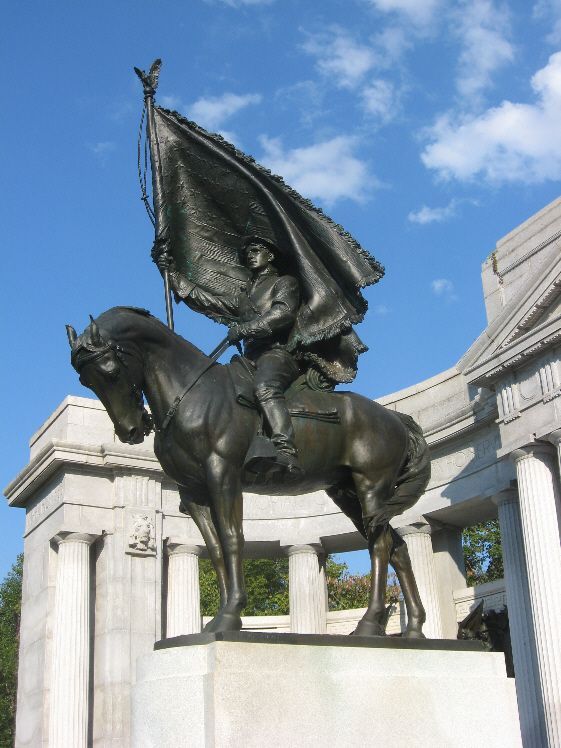

Iowa Monument
This spectacular monument in the Vicksburg National Military Park was dedicated on November 15, 1906. Governor Albert B. Cummins, General Grenville Dodge and a delegation of 150 Iowans were present for the dedication. The cost to the State of Iowa was $150,000. It is 64 feet wide and 29 feet high in the center portion. There are 6 bronze relief sculptures and a large equestrian statue. The reliefs, which depict different scenes from the Vicksburg Campaign, were done by Henry H. Kitson. The equestrian statue was done by Kitson and his wife, Theo Alice Ruggles Kitson. There is also a bronze plaque listing the 28 Iowa infantry regiments, 2 cavalry regiments and 2 batteries present at the Seige of Vicksburg.
The relief panels show Iowa soldiers and sailors in different battles leading up to the Seige of Vicksburg. They are, in order, Grand Gulf, Port Gibson, Jackson, Champion Hill, Big Black Bridge and the Iowa assault on May 22 at Vicksburg. There is a wonderful book on Vicksburg monuments, "Art of Commemoration" by Gen. Parker Hills. On its cover is the panel on the May 22 assault. He provides detailed explanation on each of the panels.
Over the years, the monument fell into disrepair. The Iowa legislature appropriated over $300,000 in 2012 for restoration. A re-dedicdation ceremony was held on May 25, 2013 with attendance by about 200 Iowans. The final photos show Gov. Terry Branstad speaking and the 49th Iowa Infantry, which served as the color guard at the ceremony. Thank you to the Jackson Clarion Ledger for the photo showing Gov. Branstad speaking.
The monument is located past Tour Stop #15 and close to the end of the tour route. The location is also near the positions of the Iowa 21st and Iowa 22nd which led the heroic charge on May 22, 1863. The first two photos were taken 10/5/08 - the others at the re-dedication of the monument on 5/25/13.
There are 13 regimental or battalion monuments which include the 32 Iowa regiments and batteries. There are also 59 bronze tablets marking positions of the various regiments on the seige line.









Captain William Titus Rigby Sculpture
William Rigby (1841-1929) was a native of Tipton, Iowa who served in Company B of the Iowa 24th Infantry Regiment. He was a 21 year old Lieutenant during the siege of Vicksburg. Later he was promoted to Captain. He returned to Iowa and became active in veteran's organizations. He became the first resident Commissioner of the Vicksburg National Park in 1899. Captain Rigby is given much credit for his foresight in establishment of the Park. He was particular in making certain that monuments and markers were positioned correctly and invited veterans to return to verify these locations.
The sculpture was completed by Henry H. Kitson in 1928. It is on Union Avenue past the Indiana Monument and before Tour Stop #15. He is buried with his wife Eva in the Vicksburg National Cemetery. See the monument for the Iowa 25th and 31st Infantry Regiments for the location. Photos taken 10/06/08.


Col. Alexander Chambers Sculpture
Alexander Chambers (1832-88) was a regular army officer and, while not an Iowa native, accepted a position as Colonel of the Iowa 16th Infantry Regiment. He was wounded slightly at Shiloh and wounded severely at Iuka. He was promoted to head "Crocker's Iowa Brigade" and led the Brigade during the Vicksburg Campaign. After the War, he returned to the regular army. The relief sculpter of Col. Chambers is located after Tour Stop #4 and near the Monument for the Iowa 11th, 13th, 15th and 16th Regiments. Photo taken 10/6/08.

Col. Cyrus Bussey Sculpture
Cyrus Bussey (1833-1915) moved to Bloomfield, Iowa in the mid-1850's and was a merchant and state legislator. When the war started, he served as an assistant to Governor Samuel Kirkwood and worked to organize the militia in SE Iowa due to panic about an invasion from Missouri. Later he became the colonel of the 3rd Iowa Cavalry. He was at the Battle of Pea Ridge and served in a number of posts in Arkansas and Missouri during the war. He also received promotions to Brigadier General and Bvt. Major General. He was chief of staff of all cavalry in the rear of Vicksburg during the seige. After the war he was a businessman and served as Assistant Secretary of the Interior from 1889-93. He is buried at Arlington National Cemetery with a large monument. This bronze relief portrait by sculptor Frank E. Elwell was erected September 12, 1911. It is located on Grant Avenue just past the African-American Monument. Photo taken 10/6/08.
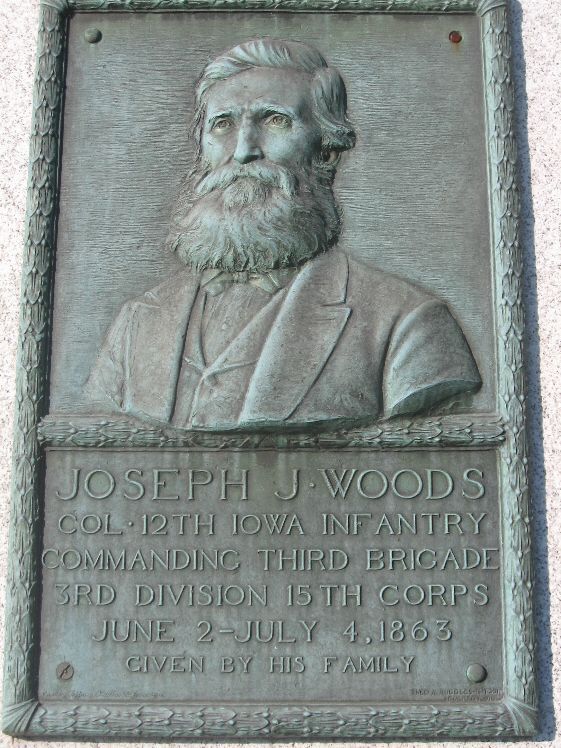
Col. Joseph J. Woods Sculpture
Joseph Woods (1823-89) was 3rd in his class of 1847 at West Point. He became a farmer in Jackson County in eastern Iowa. In 1861 he became the Colonel of the Iowa 12th Infantry Regiment. He and his regiment were in action at Ft. Donelson and the Hornet's Nest at Shiloh. After the war, he farmed in Kansas. To locate this portrait sculpture, turn left on Graveyard Road after passing Tour Stop #5. Photo taken 10/5/08.

Col. William Hall Sculpture
William Hall was born in 1832 and moved to Davenport, Iowa in 1854. He became the Colonel of the Iowa 11th Infantry Regiment and was in battles at Shiloh, Corinth and, later, at Atlanta. He was the commander of "Crocker's Iowa Brigade" during the Atlanta Campaign but resigned in disgust after the Battle of Atlanta on July 22, 1864 when Col. William Belknap of the Iowa 15th was promoted over him.
According to the NPS web site, this bronze relief portrait was erected in 1915 at a cost of $180. The scuptor was Theo Alice Ruggles Kitson. The sculpture is located past the Wisconsin monument and near the monument for "Crocker's Iowa Brigade". Photo taken 10/5/08.

General Charles L. Matthies Sculpture
Charles L. Matthies (1824-68) was born in Prussia and had military experience there before emigrating to Burlington, Iowa in 1849. He was the Colonel of the Iowa 5th Infantry Regiment before being promoted to Brigadier General in April of 1863 and holding Brigade commands. It was said his soldiers loved him and he was called "Old Dutchie". Also see his memorial on this web site in Aspen Grove Cemetery in Burlington (Des Moines County) where he is buried. His first name is listed there as the German "Karl". The relief sculpture of General Matthies is located after the Minnesota Monument but before Tour Stop #1. Photos taken 10/6/08.


General Frederick Steele Statue
Frederick Steele (1819-68) was a 1843 West Point graduate and a veteran of the Mexican War. He was a Colonel commanding the 8th Iowa Infantry Regiment - then received promotions to the Brigadier General and Major General levels. During much of the war, his command was located in Missouri and Arkansas but he commanded the 1st Division, 15th Corps at Vicksburg. He probably did not have strong ties to Iowa except for several months commanding the Iowa 8th.
This striking statue is at a spectacular location overlooking the U.S.S. Cairo Museum and National Cemetery. The U. S. Navy Monument is in the background in the photo. Photos taken 10/6/08.
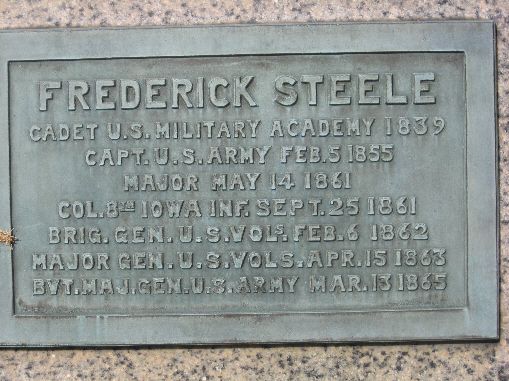


General Hugh T. Reid Sculpture
Hugh T. Reid (1811-74) moved to Keokuk, Iowa in 1843 and worked as a lawyer and railroad executive. He organized and was the colonel of the Iowa 15th. At Shiloh, the inexperienced regiment was pushed into a gap in the Union line and suffered heavy casualties. Col. Reid was knocked off his horse when shot in the neck. He was able to recover and lead his regiment with great courage. He was promoted to Brigadier General in April 1863 and was a brigade commander at the District of Lake Providence at the time of the Vicksburg Campaign. This bronze portrait sculpture is found at the far NE section of the Park just before the Kansas and African-American Monuments. Photo taken 10/6/08.

General James M. Tuttle Sculpture
James Tuttle (1823-92) was from Farmington in SE Iowa. He became the Colonel of the 2nd Iowa Infantry Regiment. He was well known for leading his regiment in a heroic charge at Ft. Donelson and for leading Tuttle's Iowa Brigade at the Hornet's Nest at Shiloh. He was promoted to General and led the 3rd Divison, XV Corps at Vicksburg. He resigned from the Army in 1864, returned to Iowa and engaged in politics and business. He is buried in Woodland Cemetery in Des Moines.
The bronze sculpture is by Theo Ruggles Kitson and was dedicated in 1912. It is located on Union Avenue between Grant Avenue and Tour Stop #6. Photos taken 10/6/08.

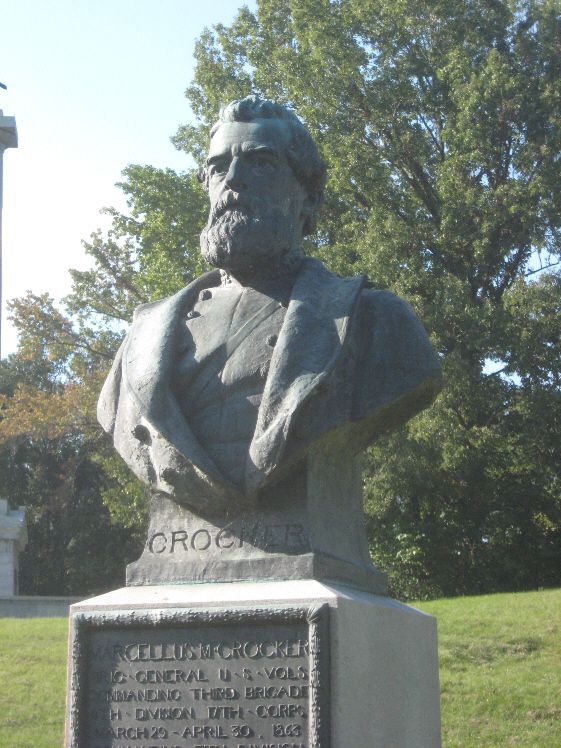
General Marcellus M. Crocker Sculpture
Marcellus M. Crocker (1830-65) came to Jefferson County in Iowa as a young man. He spent two years at West Point but had to resign due to ill health. He became a lawyer in Fairfield - then moved to Des Moines in 1855. He became the Colonel of the Iowa 13th Infantry Regiment. After heroic action at Shiloh, he was promoted and headed Crocker's Iowa Brigade. He was promoted again and was a Major General in charge of the 7th Division, 17th Corps for the Vicksburg Campaign. He had to leave his command due to sickness and was sent to a post in New Mexico in hopes his health would improve. He died of consumption (tuberculosis) in 1865. He is buried in Woodland Cemetery in Des Moines.
This sculpture is located past Tour Stop #4 and the Wisconsin Monument. Photos taken 10/5/08.



Governor Samuel J. Kirkwood Sculpture
Samuel Kirkwood (1813-94) served as Iowa Governor during the Civil War. He was a strong supporter of Abraham Lincoln and was effective in raising regiments during the War. After the War he served in the U. S. Senate and was U. S. Secretary of the Interior. He led a delegation of Iowans to Vicksburg during the siege and visited with many Iowa soldiers there. It was reported that the Governor and the delegation had a good time collecting battlefield souvenirs and even fired a few shots at the Rebs. Gov. Kirkwood is buried in Oakland Cemetery in Iowa City - also refer to his memorial there. The sculpture is located after Tour Stop #15 and just before the Iowa Monument. Photos taken 10/5/08.
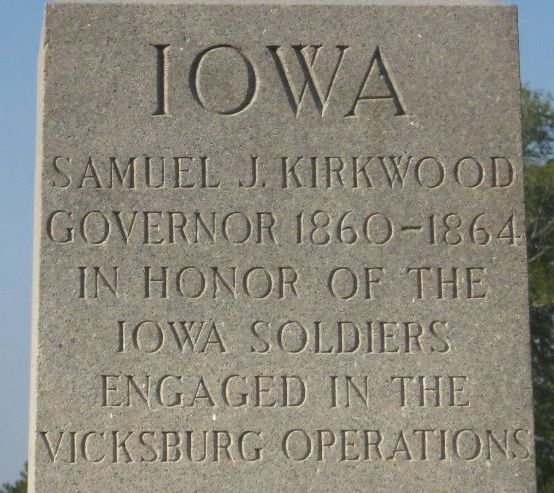
Monument for 2nd Iowa Battery
32.371650 by -90.841283
The monument is at the position of the Battery during the siege of Vicksburg. Besides action during several battles during the Vicksburg Campaign, the Battery "greatly distinguished itself" during the Battle of Corinth on October 4, 1862, according to the Iowa Roster and Record. Note the cartridge box at the peak of the monument - this is the symbol for General Sherman's 15th Corps. It is located on Graveyard Road - turn left after Tour Stop # 5. Photos taken 5/24/13.


Monument for 3rd Iowa Infantry 32.324733 by -90.869717
The Iowa 3rd was one of the first organized in the state. This monument is on the far Union left. Note the Maltese cross at the peak - this is the symbol for the 16th Corps. The monument is located outside the Military Park on the hill east of the intersection of Wisconsin Avenue and John Allen Street. Photos taken 5/26/13.


Monument for Herron's Division - 19th, 20th, 34th and 38th Iowa Infantry 32.309767 by -90.893217
This monument was for regiments in General Francis Herron's Division on the south edge of the Vicksburg siege line. Unfortunately, the monument was cut off from the Park many years ago - there is limited access to it and it has been overgrown with brush. Also, the bronze plaques for each regiment were missing (presumably stolen). The 49th Iowa Infantry of the Sons of Union Veterans, Iowa Department, has raised funds for replacement plaques and these were recently installed by the Park Service. Work still needs to be done to open access to the public or move the monument to a better location. There are also two other state monuments as shown in the first photo. The location is between I-20 on the north and a shopping center on the south. Thank you to Jim and Andrew Braden for their effort to access the monument and for their photos - taken 5/26/13.
The last photo shows the sculpture of General Francis Herron. Herron was an Iowa native who was best known for receiving the Medal of Honor for heroic action in the Battle of Pea Ridge. He also was the victorious Union Commander in the Battle of Prairie Grove. This sculpture was by Solon H. Borghlum and was erected in 1914. The monument is located near the Pemberton Square Mall on Pemberton Blvd.





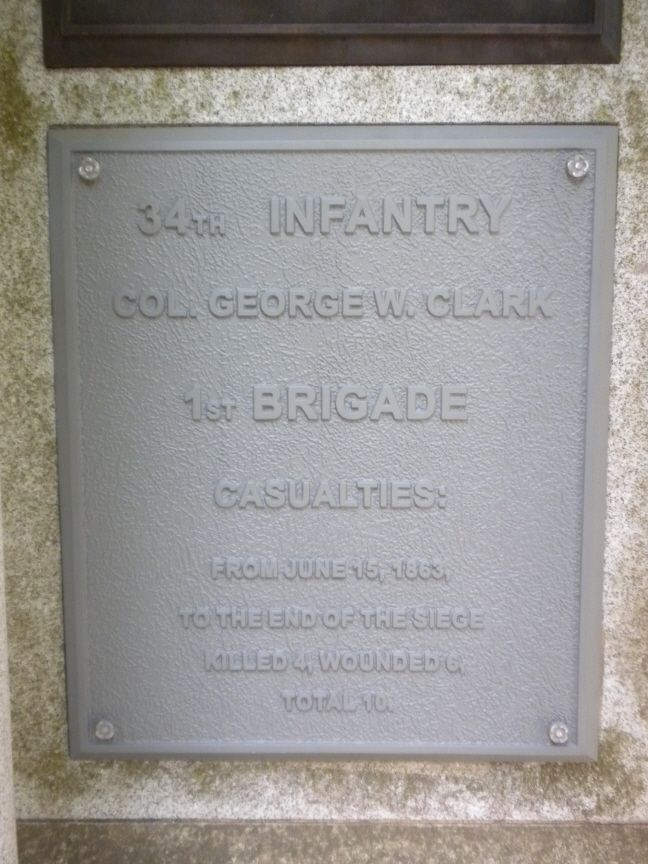

Monument for 11th, 13th, 15th and 16th Iowa Infantry
This is the famous "Crocker's Iowa Brigade". These regiments had been in the battles at Shiloh and Corinth and later were in the Battle of Atlanta and on the March to the Sea. General Marcellus Crocker was now a division commander and this brigade was commanded by Col. Alexander Chambers at Vicksburg. Note the arrow at the peak of the monument - this is the symbol for General McPherson's 17th Corps. It is located past Tour Stop #4 and the Wisconsin Monument and near the statue of General Crocker. Photos taken 10/5/08.




Monument for 1st Iowa Battery 32.376817 by -90.855700
According to the Iowa Roster and Record, "the First Iowa Battery was actively engaged in the siege, firing over thirteen hundred rounds from each of its guns. No field battery among the great number engaged in the long line of investment of the doomed city was more active or contributed more fully to the glorious result of its capture than the First Iowa."
It is located on Union Avenue past Tour Stop #6. Photos taken 10/6/08.
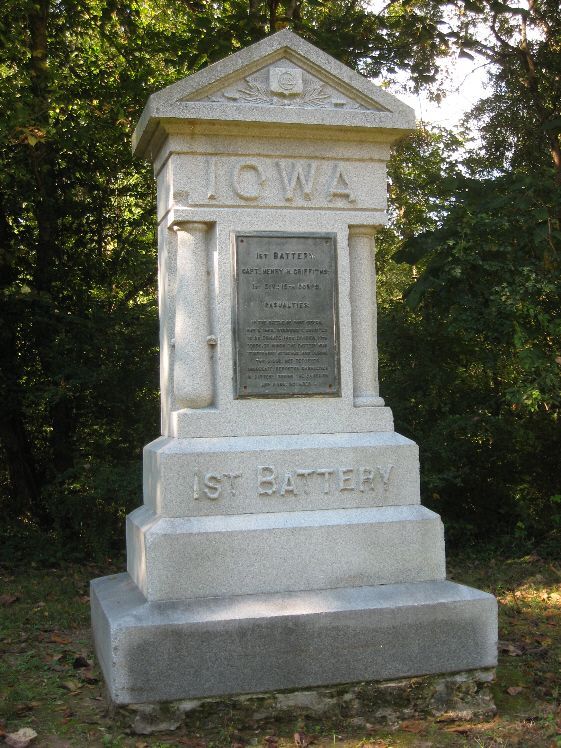

Monument for 21st, 22nd, and 23rd Iowa Infantry
The Iowa 21st and 22nd took the lead in the assault of May 22, 1863. The Iowa 22nd actually planted their colors at a Confederate fortification called the Railroad Redoubt or Fort Beauregard but were driven back after a counterattack. This was the deepest penetration by any Union troops during the attack on May 22. The casualties of the 22nd were also the highest with 27 killed, 118 wounded, and 19 captured. The Iowa 23rd charged the Confederates at the Battle of Big Black River on May 17 - Colonel William Kinsman led the charge and was wounded severely and died of his wounds the following day. This monument is just past the Iowa Monument. Also shown are position markers. The final two assault markers are on the Confederate line at the Railroad Redoubt. This is near the Texas Monument. Photos taken 10/5/08, 5/24/13 and 5/26/13.







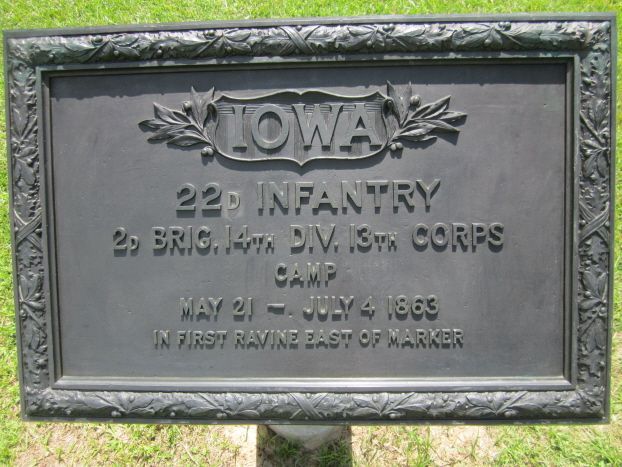


Monument for 24th and 28th Iowa Infantry
Both the Iowa 24th and Iowa 28th were heavily engaged at the Battle of Champion Hill east of Vicksburg on May 16, 1863. They also were engaged in the siege of the City. This monument is past the Indiana Monument and before Tour Stop #15. It was cleaned and restored in 2013. Note the "13" at the peak of the monument, which refers to the 13th Corps headed by General John McClernand. Six bronze position markers are also shown. The Camp and Sharpshooter markers are near the road past the Rigby monument. The Advanced Sharpshooter markers are away from the road between the Union and Confederate Lines. Photos taken 5/24/13 and 5/25/13.







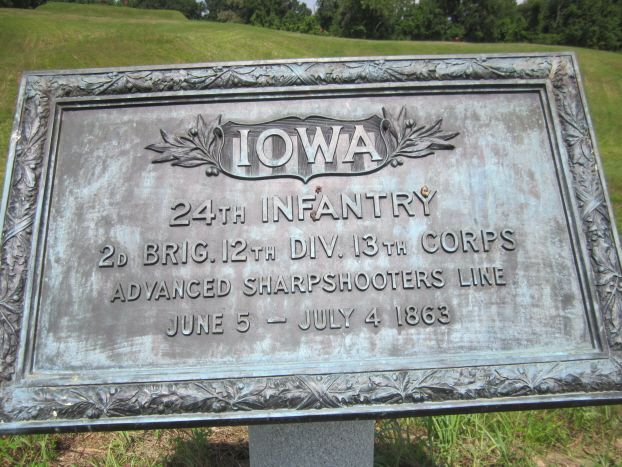

Monument for 25th and 31st Iowa Infantry
Both the Iowa 25th and Iowa 31st were in the assault on May 22. This monument is in the Vicksburg National Cemetery. Monuments at Vicksburg were erected based on the position of the regiment in the battle regardless of the location. There are also nearby position markers for the two regiments. To find the monument, follow the drive around the overlook at the far side of the Cemetery. The position markers are just past the monument on the road. Captain William Titus Rigby, from Iowa, the first Commissioner of the Vicksburg National Park, is buried nearby with his wife Eva - see the flat stones to the right of the monument. Photos taken 10/6/08 and 5/24/13.

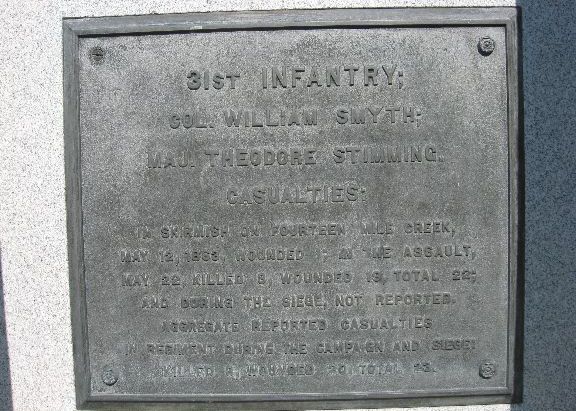


Monument for 3rd and 4th Iowa Cavalry
Both of these cavalry units spent much of the war in operations west of the Mississippi. The Iowa 4th Cavalry was in earlier battles in the Campaign leading up to the seige of Vicksburg. During the seige, both had the very important duty to guard the rear as an attack by Confederate General Joseph Johnston from the east was of great concern. The monument is located on Sherman's Circle in the NE corner of the Park. Photos taken 10/6/08.



Monument for 4th, 9th, 26th, and 30th Iowa Infantry
The Iowa 4th, 9th, 26th and 30th were part of the 3rd Brigade, 1st Division, 15th Corps. They participated in the assaults on May 19 and again on May 22, 1863 and suffered heavy casualties. These assaults against strong Confederate fortifications were unsuccessful and General Grant changed his strategy and began a seige of the city. This monument is on Union Avenue just before Tour Stop #6.
Also shown are several position markers. The 9th Iowa sharpshooter marker is hidden in the woods past the monument. The 26th Iowa assault marker on May 22 shows their position almost on the Confederate line at the 26th Louisiana Redoubt. Photos taken 10/6/08, 5/24/13 and 5/26/13.


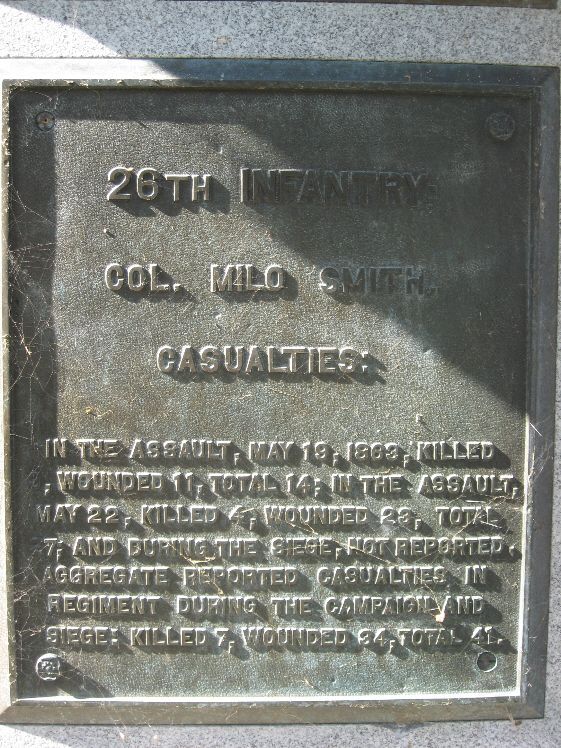



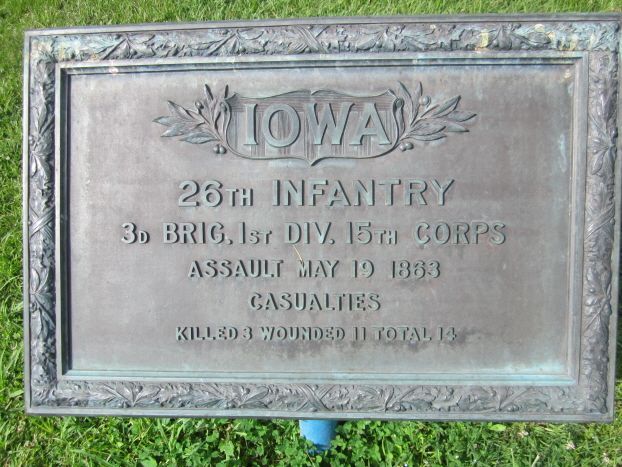




Monument for 5th, 10th and 17th Iowa Infantry
The Iowa 5th, 10th and 17th were all involved in several battles in the Vicksburg Campaign. They were heavily involved in the Battle at Champion Hill on May 16 and the assault on Vicksburg on May 22. The monument is located early on the tour route - before Tour Stop #1. There are also three nearby camp position markers on the right side of the road Photos taken 10/5/08. Position marker photos taken 5/26/13.
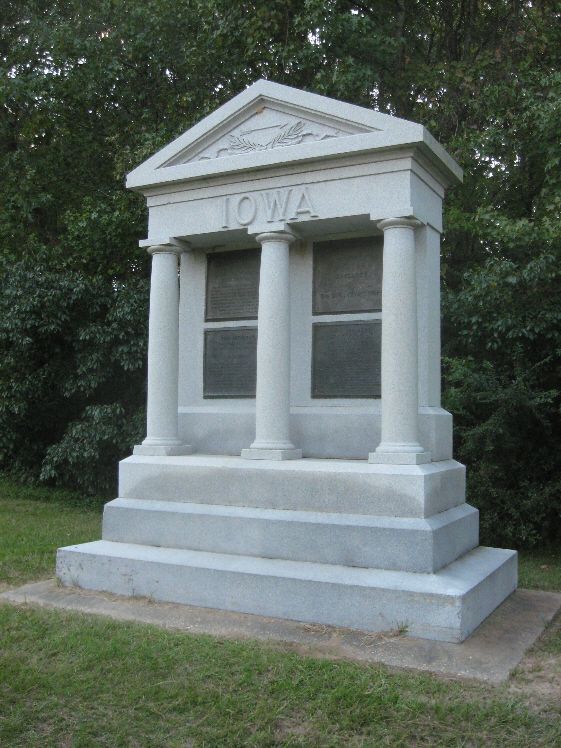





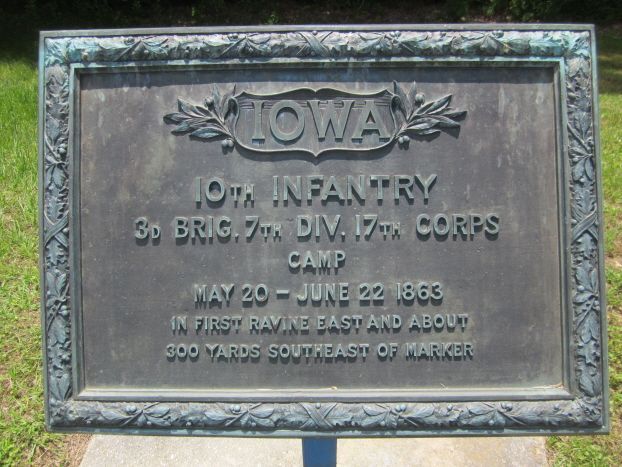

Monument for 6th and 40th Iowa Infantry
Both of these regiments were at nearby Haynes' Bluff during the seige. The Iowa 6th was at Shiloh and later at Missionary Ridge, the Atlanta Campaign and the March to the Sea. The Iowa 40th had limited combat activity during the war, except for the Battle of Jenkins' Ferry, Arkansas on April 30, 1864. The monument is located at Sherman's Circle in the NE section of the Park. Photos taken 10/6/08.

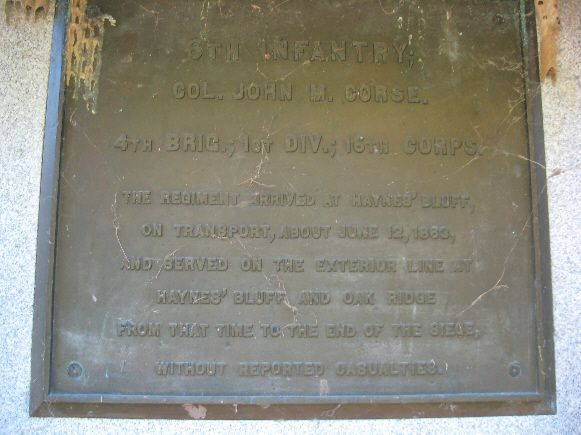

Monument for 8th, 12th and 35th Iowa Infantry
The Iowa 8th and 12th were both in the Hornet's Nest at Shiloh and there are monuments there for these two regiments. The Iowa 35th was organized later but served in a number of subsequent actions including the Red River Campaign in Louisiana and the Battle at Nashville. Also shown are camp and assault position markers. After Tour Stop #5, turn left on Graveyard Road to locate the monument. The position markers are nearby. The camp marker for the 12th is down a steep ravine and difficult to locate. Photos taken 10/5/08, 5/24/13 and 5/26/13.

